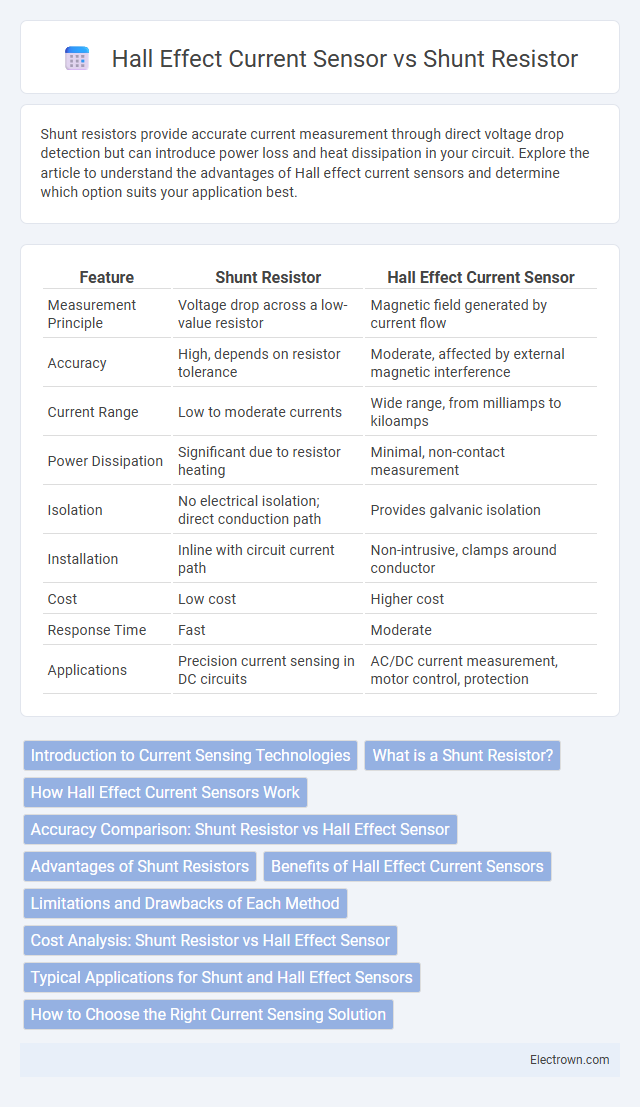Shunt resistors provide accurate current measurement through direct voltage drop detection but can introduce power loss and heat dissipation in your circuit. Explore the article to understand the advantages of Hall effect current sensors and determine which option suits your application best.
Table of Comparison
| Feature | Shunt Resistor | Hall Effect Current Sensor |
|---|---|---|
| Measurement Principle | Voltage drop across a low-value resistor | Magnetic field generated by current flow |
| Accuracy | High, depends on resistor tolerance | Moderate, affected by external magnetic interference |
| Current Range | Low to moderate currents | Wide range, from milliamps to kiloamps |
| Power Dissipation | Significant due to resistor heating | Minimal, non-contact measurement |
| Isolation | No electrical isolation; direct conduction path | Provides galvanic isolation |
| Installation | Inline with circuit current path | Non-intrusive, clamps around conductor |
| Cost | Low cost | Higher cost |
| Response Time | Fast | Moderate |
| Applications | Precision current sensing in DC circuits | AC/DC current measurement, motor control, protection |
Introduction to Current Sensing Technologies
Shunt resistors measure current by detecting the voltage drop across a known resistance, offering high accuracy and simplicity in low-voltage applications. Hall effect current sensors utilize magnetic fields generated by current flow, enabling contactless measurement and isolation from high voltages, ideal for high-power and variable environments. Both technologies serve critical roles in electronic systems, with selection depending on factors like current range, accuracy requirements, and environmental conditions.
What is a Shunt Resistor?
A shunt resistor is a precise, low-resistance component used to measure electrical current by detecting the voltage drop across it, allowing for accurate current sensing in various circuits. It provides direct current measurement with high accuracy and fast response time, making it suitable for applications requiring stable and consistent readings. You can rely on shunt resistors for cost-effective current monitoring, especially in environments where temperature stability and detailed analysis are critical.
How Hall Effect Current Sensors Work
Hall effect current sensors operate by detecting the magnetic field generated by current flowing through a conductor; a Hall element placed within this magnetic field produces a voltage proportional to the current. Unlike shunt resistors that measure voltage drop directly across a known resistance, Hall sensors provide galvanic isolation and can measure AC and DC currents without power loss. This makes Hall effect sensors suitable for high-accuracy, non-intrusive current monitoring in applications such as electric vehicles and industrial motor control.
Accuracy Comparison: Shunt Resistor vs Hall Effect Sensor
Shunt resistors provide high accuracy in current measurement due to their direct voltage drop measurement, typically achieving precision within +-0.1% under stable temperature conditions. Hall effect current sensors offer lower accuracy, generally ranging from +-1% to +-3%, influenced by external magnetic fields and temperature variations. For applications demanding precise current monitoring, especially in DC systems, shunt resistors are favored over Hall effect sensors despite potential power loss from resistor heating.
Advantages of Shunt Resistors
Shunt resistors offer precise current measurement with high accuracy and linearity, making them ideal for applications requiring exact current monitoring. Their low cost, simple design, and ease of integration with existing circuits provide a budget-friendly solution compared to Hall effect current sensors. Furthermore, shunt resistors deliver fast response times and are unaffected by external magnetic fields, ensuring reliable performance in noisy environments.
Benefits of Hall Effect Current Sensors
Hall effect current sensors provide galvanic isolation between the measured circuit and the sensor, enhancing safety and reducing noise interference. They offer non-intrusive, contactless measurement with a wide dynamic range and can detect both AC and DC currents accurately. Their compact size and fast response time make them ideal for real-time current monitoring in industrial and automotive applications.
Limitations and Drawbacks of Each Method
Shunt resistors, while highly accurate for measuring low currents, introduce power loss and heat dissipation due to their inherent resistance, which limits efficiency and can affect circuit stability. Hall effect current sensors provide galvanic isolation and are suitable for measuring high currents, but they suffer from lower accuracy and sensitivity to external magnetic fields and temperature variations. Both methods face trade-offs: shunt resistors require precise calibration to minimize errors, whereas Hall effect sensors demand complex compensation techniques to maintain measurement reliability in noisy environments.
Cost Analysis: Shunt Resistor vs Hall Effect Sensor
Shunt resistors generally offer a lower upfront cost compared to Hall effect current sensors, making them an economical choice for applications with strict budget constraints. Hall effect sensors, while more expensive initially, provide non-intrusive current measurement with better isolation and reduced power losses, potentially lowering long-term maintenance and operational costs. The total cost of ownership for Hall effect sensors can be advantageous in systems requiring high accuracy and safety standards despite their higher initial investment.
Typical Applications for Shunt and Hall Effect Sensors
Shunt resistors are typically used in applications requiring precise current measurement with low cost and high accuracy, such as battery monitoring, power supplies, and motor control systems. Hall effect current sensors are favored in situations needing galvanic isolation and the ability to measure high currents, including electric vehicles, industrial automation, and renewable energy systems. Your choice depends on the need for accuracy, isolation, and the current range in your specific application.
How to Choose the Right Current Sensing Solution
Choosing the right current sensing solution depends on factors like accuracy requirements, current range, and installation constraints. Shunt resistors provide high accuracy and fast response for low to medium currents but generate heat and voltage drop, making them ideal for precise measurements in controlled environments. Hall effect current sensors offer galvanic isolation and handle higher currents without power loss, making them suitable for applications requiring electrical isolation and minimal signal interference.
Shunt resistor vs Hall effect current sensor Infographic

 electrown.com
electrown.com